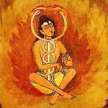Brahma temple of Pushkar
Only temple of Lord Brahma

There is a temple on every corner of India’s village, town, and city. If you count, there shall be millions of temples in India. Even though the Divine meets us in many forms, Lord Brahma, Lord Vishnu, and Lord Shiva are considered the holy trinity of Hinduism.
Even though you will find hundreds of thousands of temples dedicated to Lord Shiva and Vishnu, there is only one temple dedicated to Lord Brahma. Despite being one of the holy trinity of Hinduism, have you ever wondered why there aren’t many temples dedicated to Lord Brahma? Today, in the blog series of mysterious temples in India, we will visit this temple in the city of Pushkar, which is considered the only temple of Brahma on earth.
The cursed God
God is portrayed as someone almighty who cannot do wrong in most cultures and religions. Even though he commits a mistake, he is not answerable to anyone, or it’s considered part of his grand plan. Sanatana Dharma or Hinduism slightly differs when it comes to the mistaken Gods.
In Hinduism, Lord Brahma is considered the generator, and Lord Vishnu is the nurturer of the universe. Once, a debate took place between both on who is the greatest among the creator and nurturers. Amidst the heated and never-ending debate, an endless illuminated pillar appeared between both debating Gods.
Seeing the futility of the debate, both the Gods settled on a competition. The one who will find the end of that pillar first shall be declared the mightiest one, decided by the generator and the nurturer. Vishnu transformed himself into the Varaha (wild boar) and dove towards the bottom of the pillar. Lord Brahma, taking the form of a swan, flies upwards to search for the end of that pillar.
After a few years of searching, Lord Vishnu realised that this was not the ordinary pillar, and he came back where he started. When he reached the starting point, he saw Lord Brahma already waiting there, holding a Kewada (screw pine) flower in his hand. Brahma told Vishnu that he had found the upper end of the pillar, and the live Kewda flower was the witness to it. When asked, the Kewda flower supported the claim of Brahma.
While the flower was giving his witness account, the pillar split. Lord Shiva appeared from that pillar, looking furious and declaring that he was the pillar. As he has no beginning and end, this pillar also has no beginning and no end.
He praised Lord Vishnu for telling the truth and cursed Lord Brahma for lying. Shiva cursed Lord Brahma that there shall be no other temple where Brahma will be prayed. He also condemned the flower that no devotee will present Kewda to any deity from now on. It is said that there was only one temple in Pushkar Rajasthan, where people used to pray to Lord Brahma during those times, making it the only and last temple of the Lord Brahma.
The second story is also related to this place. Brahma was performing a Yagya on the shores of the Pushkar Lake to protect the world from all the evil in the universe. Brahma needed a better half to perform her duties to the Yagya during a critical point of this spiritual ceremony. But Lord Brahma’s wife, Divine Mother Savitri, was nowhere to be found. Seeing the moment’s importance, he married a princess named Gayatri, and with her help, the Yagya ceremony was completed.
Savitri arrived on the scene and got furious with Brahma. She cursed her husband that he shall not be worshipped anywhere. Being the Divine feminine, she cooled off after some time and said that Brahma is allowed in worship, but only in the holy places like Pushkar.
Brahma temple of Pushkar
Pushkar Lake or Pushkar Sarovar is located in the Ajmer district of Rajasthan. It said that when Brahma slew the demon Vajranabha with his almighty lotus, three petals fell down on earth, creating three lakes of Pushkar. Brahma temple is located on the shore of this holy lake.
The temple has a vast premise. The main temple is built in classic Rajasthani-style architecture, with a Nagara-styled sanctum sanctorum pointing towards the sky. Red-colored 70 feet santorum tower has a swan flag, a symbol of Brahma’s flattering height in the sky. The rest of the entire temple is built in marble.
The idol of the Lord Brahma, sitting in the sanctum sanctorum of the temple, is carved in white marble. In 716AD, the great sage Adi Shankara consecrated this Vigraha (idol) of Lord Brahma. Since then, Puja has been carried out by generations of priests.
Here, Lord Brahma is sitting in a cross-legged position, four-faced and four-handed. Each hand and each face represents one cardinal direction. He holds a Kamandalu (water pot), rosary, a book, and the grass. The rosary represents infinite time, the Kamandalu represents the universe generating celestial waters, the book illustrates the self and the universal knowledge, and Kusha grass describes the sacrifice necessary to obtain absolute knowledge. You can see the small Vigraha of the Divine Mother Gayatri, sitting beside him on his left side.
-As Yagya was performed on this holy land, in the presence of all the Gods, a dip in this lake assures salvation from all sins. Devotees take a dip in these sacred waters and then come on the doorsteps of Lord Brahma.
-On the whole night month of Kartik, hundreds of thousand devotees gather here to receive the creator’s blessing on the auspicious time.
-Devotees lining up outside the temple believe that Lord Being creator keeps the marriages intact.
-Lord Brahma is God of symbols, speech, and language. Children who face speech impediment issues come here to receive blessings from Lord Brahma to improve their communications.
-Swan is the vehicle of Lord Brahma. Swan is known for the Neer-Kshir Viveka (virtue of separating good and mal). People who are starting a new business come here to seek the blessings of the Lord, so, like the swan, they also will gain the ability to make the right decisions at the right time.
– There is a cowshed on the temple premises. Cows in this shade are called Brahma’s cows. Devotees feed Rotis spread with Ghee (clarified butter) and jaggery to the cows for a better future. They believe that feeding grass to the cows yields protection from the hostile forces of the surroundings.
About the Creator
Aditya Sharma111
Hi there! I am Aditya Sharma, a spiritual writer. As a writer, I have the privilege of delving into the realms of spirituality and exploring the profound aspects of the human experience.






Comments
There are no comments for this story
Be the first to respond and start the conversation.